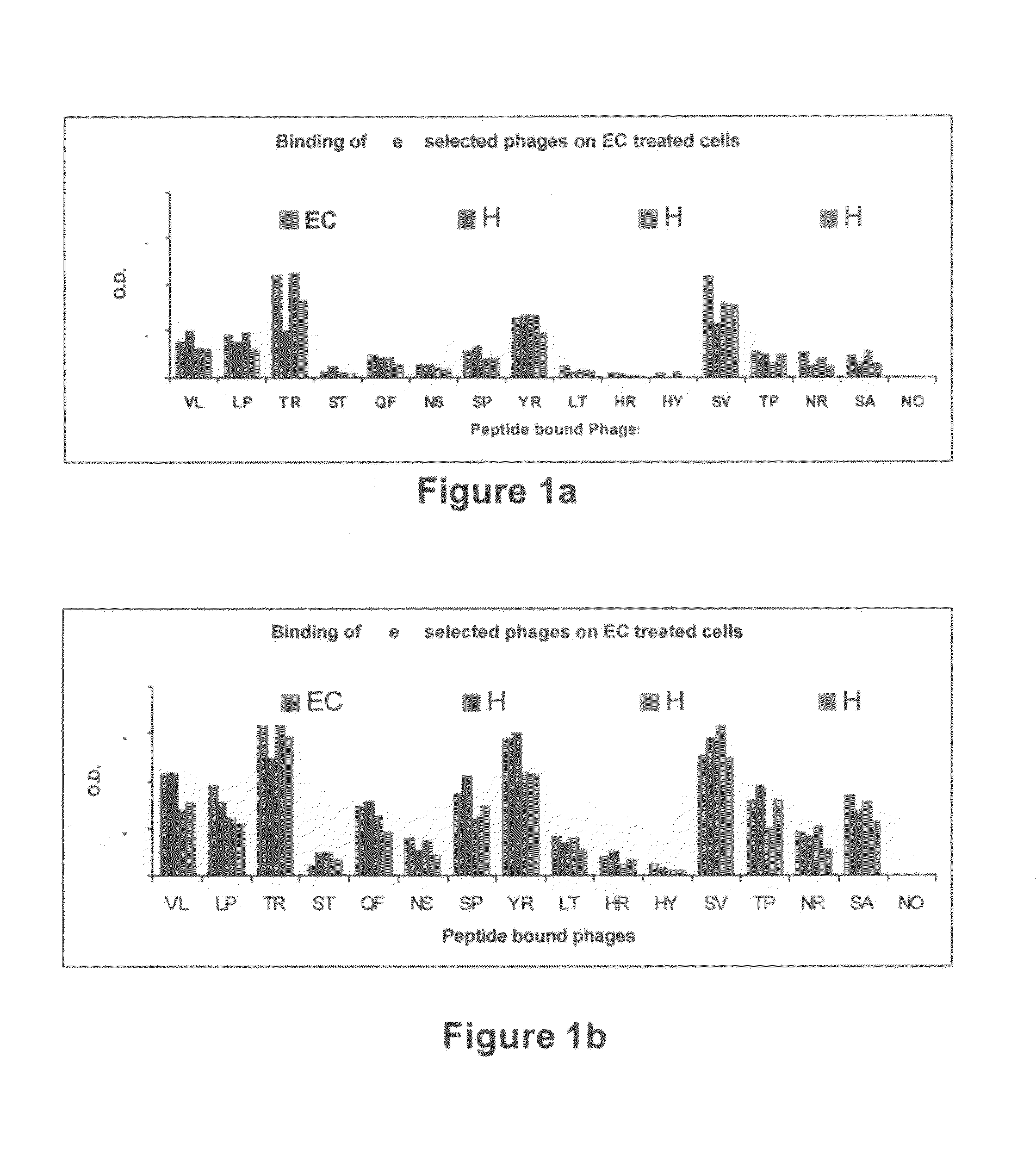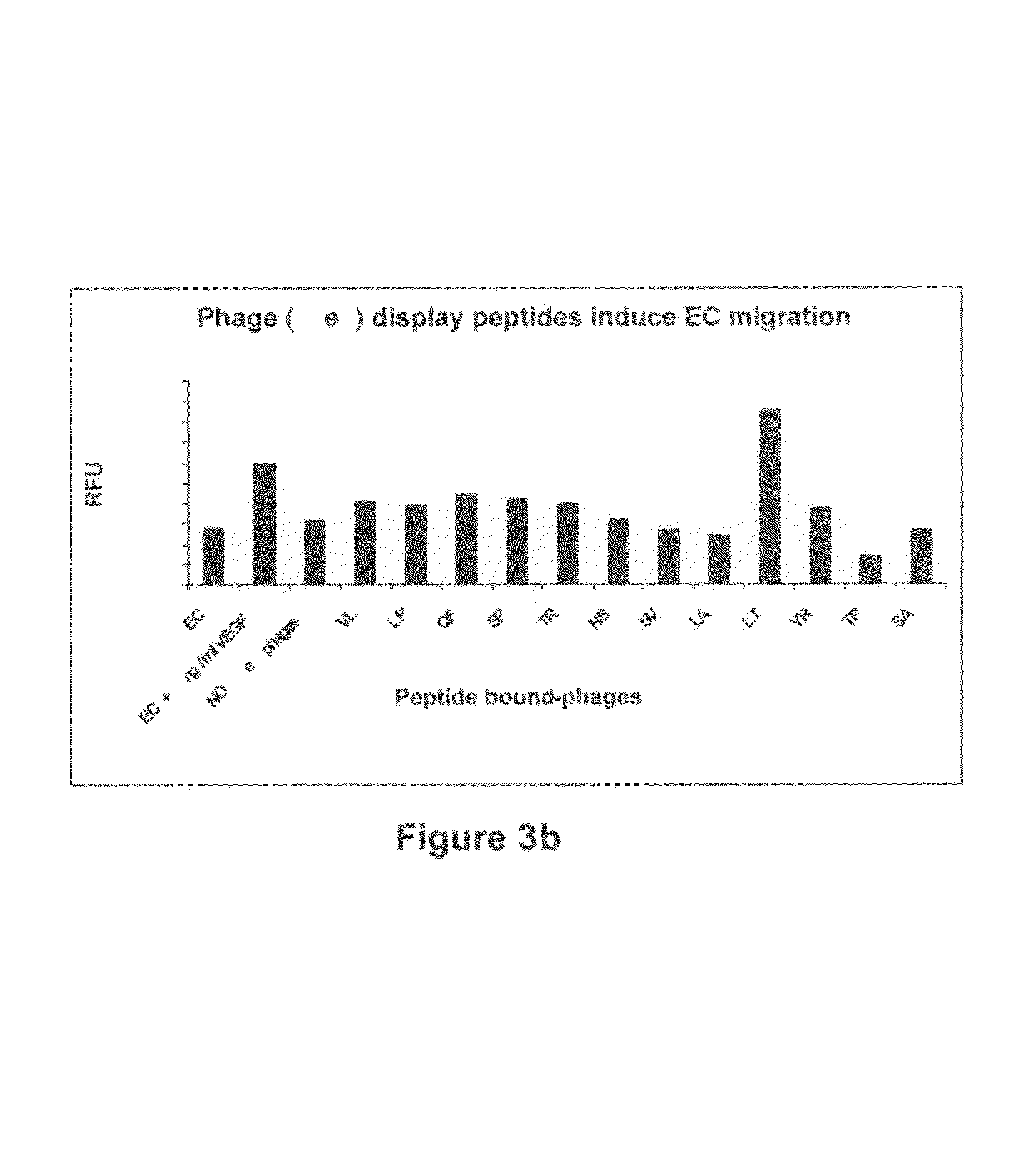Angiogenic peptides and uses thereof
a technology of angiogenic peptides and peptides, which is applied in the field of angiogenic peptides, can solve the problems of insufficient number of blood vessels, significant limitations in treatment methods, and insufficient amounts of new blood vessels or insufficient amounts of blood vessels, and achieve the effect of promoting angiogenesis
- Summary
- Abstract
- Description
- Claims
- Application Information
AI Technical Summary
Problems solved by technology
Method used
Image
Examples
example 1
Selection of Novel Potential Angiogenesis-Inducing Phage Display Peptides
[0161]Novel peptides that potentially induce angiogenesis were identified by positive affinity selection (i.e., biopanning) of a random phage display peptide library using human umbilical vein endothelial cells [HUVECs, ECs (the two abbreviations are used interchangeably throughout the document)], followed by Enzyme-Linked Immunosorbent Assay (ELISA) of positive phage clones to ECs.
[0162]Materials and Experimental Methods
[0163]Phage Display Peptide Library—The Random Phage Display Peptide Library employed in this study was purchased from New England Biolabs (NEB), Inc. (Beverly, Mass., USA). The phage display library is based on a combinatorial library of random peptide 12-mers fused to a minor coat protein (pIII) of M13 phage. The displayed 12-mer peptides are expressed at the N-terminus of pIII. The library consists of about 2.7×109 electroporated sequences amplified once to yield 20 copies of each sequence i...
example 2
Selected Peptide-Presenting Phages are Capable of Inducing Angiogenesis In Vitro
[0174]The ability of selected peptide-presenting phages to induce angiogenesis in vitro was evaluated by inducing EC proliferation, migration or sprouting of aortic rings.
[0175]Materials and Experimental Methods
[0176]Identification of DNA sequences from selected peptide-presenting phages—DNA from all isolated selected clones was purified by incubation with iodide buffer and ethanol according to the manufacturer's instructions (NEB, Beverly, Mass., USA). This rapid procedure produces template of sufficient purity for automated DNA sequencing with dye-labeled dideoxynucleotides. The 96 gIII (NEB) sequencing primer was utilized for automated DNA sequencing by the Sequencing Unit of Tel Aviv University, Tel Aviv, Israel.
[0177]ECs and hypoxia treatment—ECs were isolated, cultured, and subjected to hypoxia treatments as described in Example 1, hereinabove.
[0178]EC proliferation assay—ECs (40×103 cells / well) we...
example 3
Synthetic Peptides are Capable of Inducing Angiogenesis In Vitro Under Normoxic Conditions
[0192]Peptides corresponding to the selected peptide-presenting phages were synthesized and their potential to induce angiogenesis in vitro was evaluated, as follows.
[0193]Materials and Experimental Methods
[0194]Peptide synthesis—Peptides were synthesized by SynPep (Dublin, Calif., USA). HPLC purity analysis demonstrated that the purity of each synthetic peptide was higher than 97%. Peptide QF was dissolved in 50% water / 50% acetonitrile. All other peptides were dissolved in water.
[0195]Fluorescein labeling of synthetic peptides—Fluorescein Isothiocyanate (FTIC, Pierce, Rockford, Ill.) is an amino-reactive probe that reacts in an alkine environment with primary amines to form a stable fluorescent derivative. 12.5 μl of FITC (10 mg / ml) were added per 1 mg of peptide diluted in 0.5 M bicarbonate buffer (pH 9.5) and agitated in the dark for 2 hours. 0.1 ml of 1.5 M hydroxilamine was then added per ...
PUM
| Property | Measurement | Unit |
|---|---|---|
| concentrations | aaaaa | aaaaa |
| concentrations | aaaaa | aaaaa |
| concentrations | aaaaa | aaaaa |
Abstract
Description
Claims
Application Information
 Login to View More
Login to View More - R&D
- Intellectual Property
- Life Sciences
- Materials
- Tech Scout
- Unparalleled Data Quality
- Higher Quality Content
- 60% Fewer Hallucinations
Browse by: Latest US Patents, China's latest patents, Technical Efficacy Thesaurus, Application Domain, Technology Topic, Popular Technical Reports.
© 2025 PatSnap. All rights reserved.Legal|Privacy policy|Modern Slavery Act Transparency Statement|Sitemap|About US| Contact US: help@patsnap.com



